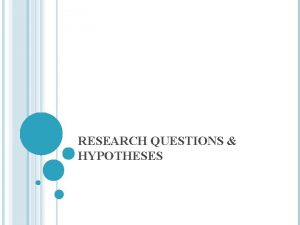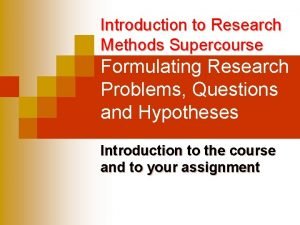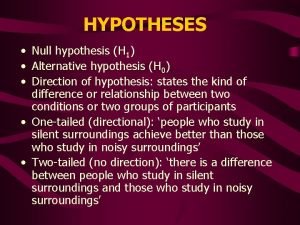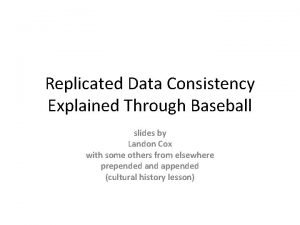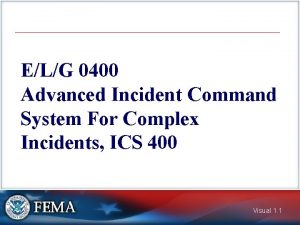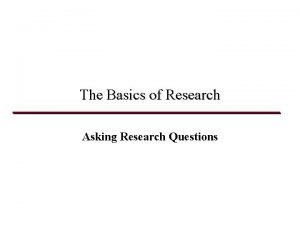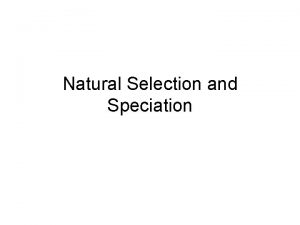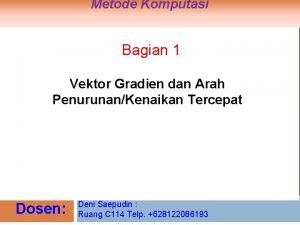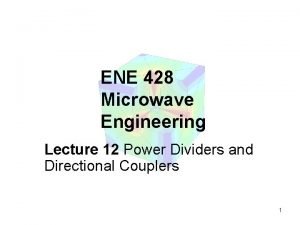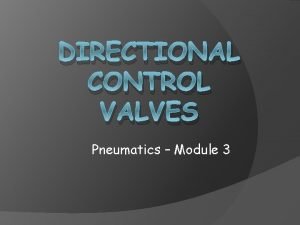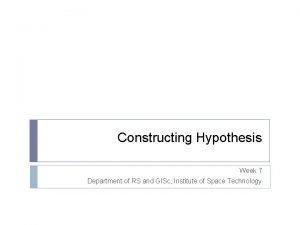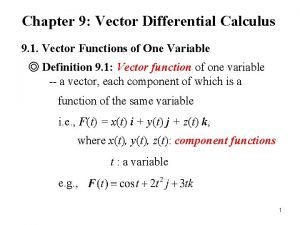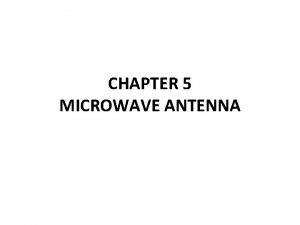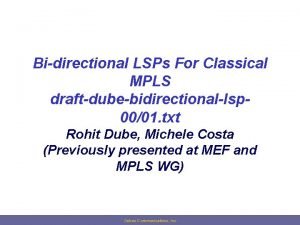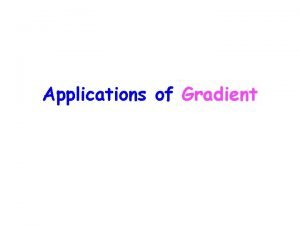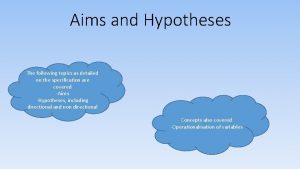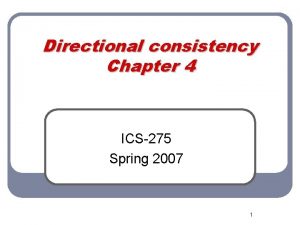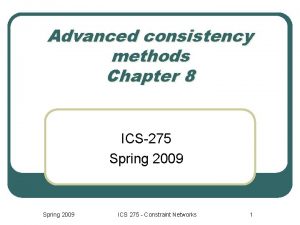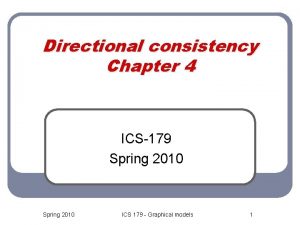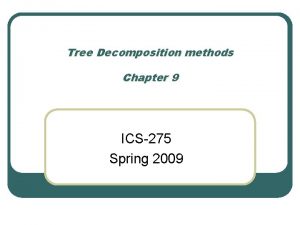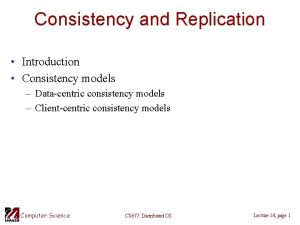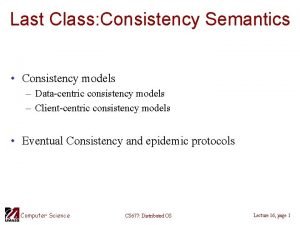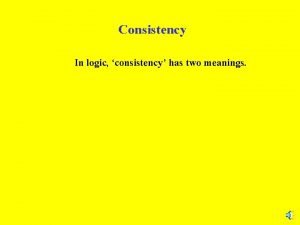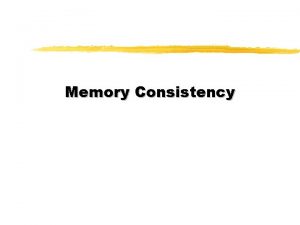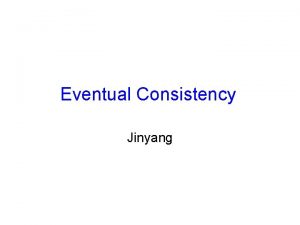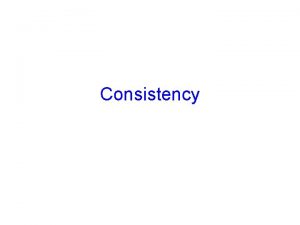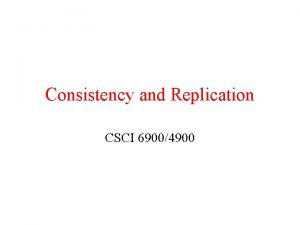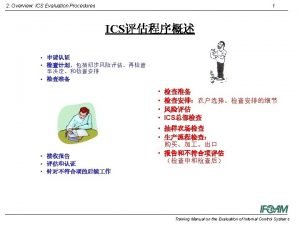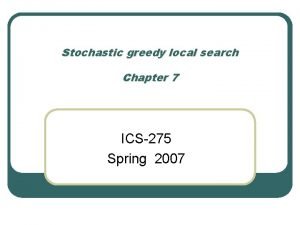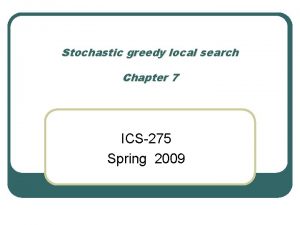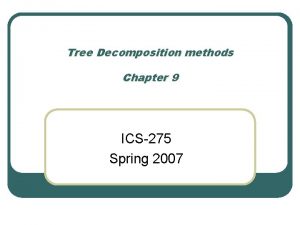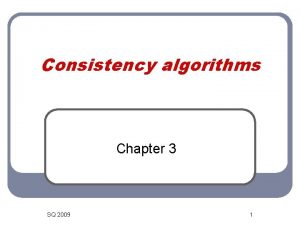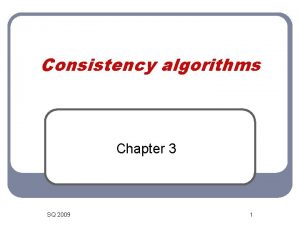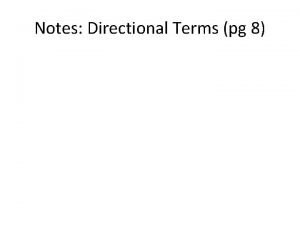Directional consistency Chapter 4 ICS275 Spring 2009 ICS









































- Slides: 41

Directional consistency Chapter 4 ICS-275 Spring 2009 ICS 275 - Constraint Networks 1

Backtrack-free search: or What level of consistency will guarantee globalconsistency Spring 2009 ICS 275 - Constraint Networks 2

Directional arc-consistency: another restriction on propagation D 4={white, blue, black} D 3={red, white, blue} D 2={green, white, black} D 1={red, white, black} X 1=x 2, x 1=x 3, x 3=x 4 Spring 2009 ICS 275 - Constraint Networks 3

Directional arc-consistency: another restriction on propagation D 4={white, blue, black} D 3={red, white, blue} D 2={green, white, black} D 1={red, white, black} X 1=x 2, x 1=x 3, x 3=x 4 Spring 2009 ICS 275 - Constraint Networks 4

Directional arc-consistency: another restriction on propagation l l l l l D 4={white, blue, black} D 3={red, white, blue} D 2={green, white, black} D 1={red, white, black} X 1=x 2, x 1=x 3, x 3=x 4 After DAC: D 1= {white}, D 2={green, white, black}, D 3={white, blue}, D 4={white, blue, black} Spring 2009 ICS 275 - Constraint Networks 5

Algorithm for directional arcconsistency (DAC) l Complexity: Spring 2009 ICS 275 - Constraint Networks 6

Directional arc-consistency may not be enough Directional path-consistency Spring 2009 ICS 275 - Constraint Networks 7

Algorithm directional path consistency (DPC) Spring 2009 ICS 275 - Constraint Networks 9

Example of DPC Spring 2009 ICS 275 - Constraint Networks 10

Directional i-consistency Spring 2009 ICS 275 - Constraint Networks 11

Algorithm directional i-consistency Spring 2009 ICS 275 - Constraint Networks 13

The induced-width DPC recursively connects parents in the ordered graph, yielding: l l Width along ordering d, w(d): • Induced width w*(d): • The width in the ordered induced graph Induced-width w*: • Smallest induced-width over all orderings Finding w* • Spring 2009 max # of previous parents NP-complete (Arnborg, 1985) but greedy heuristics (min-fill). ICS 275 - Constraint Networks 14

Induced-width Spring 2009 ICS 275 - Constraint Networks 15

Examples Three orderings : d 1 = (F, E, D, C, B, A), its reversed ordering d 2 = (A, B, C, D, E, F), and d 3 = (F, D, C, B, A, E). Orderings from bottom to top, The parents of A along d 1 are {B, C, E}. Width of A along d 1 is 3, of C along d 1 is 1, of A along d 3 is 2. w(d 1) = 3, w(d 2) = 2, and w(d 3) = 2. The width of graph G is 2. Spring 2009 ICS 275 - Constraint Networks 16

Induced-width and DPC l l The induced graph of (G, d) is denoted (G*, d) The induced graph (G*, d) contains the graph generated by DPC along d, and the graph generated by directional iconsistency along d Spring 2009 ICS 275 - Constraint Networks 17

Refined Complexity using induced-width l l l Consequently we wish to have ordering with minimal induced-width Induced-width is equal to tree-width to be defined later. Finding min induced-width ordering is NP-complete Spring 2009 ICS 275 - Constraint Networks 18

Greedy algorithms for iducedwidth • Min-width ordering • Max-cardinality ordering • Min-fill ordering • Chordal graphs Spring 2009 ICS 275 - Constraint Networks 19

Min-width ordering Spring 2009 ICS 275 - Constraint Networks 20

Min-induced-width Spring 2009 ICS 275 - Constraint Networks 21

Min-fill algorithm l l Prefers a node who add the least number of fill-in arcs. Empirically, fill-in is the best among the greedy algorithms (MW, MIW, MF, MC) Spring 2009 ICS 275 - Constraint Networks 22

Cordal graphs and Maxcardinality ordering l l l A graph is cordal if every cycle of length at least 4 has a chord Finding w* over chordal graph is easy using the max-cardinality ordering If G* is an induced graph it is chordal K-trees are special chordal graphs. Finding the max-clique in chordal graphs is easy (just enumerate all cliques in a maxcardinality ordering Spring 2009 ICS 275 - Constraint Networks 23

Example We see again that G in Figure 4. 1(a) is not chordal since the parents of A are not connected in the max-cardinality ordering in Figure 4. 1(d). If we connect B and C, the resulting induced graph is chordal. Spring 2009 ICS 275 - Constraint Networks 24

Max-caedinality ordering Figure 4. 5 The max-cardinality (MC) ordering procedure. Spring 2009 ICS 275 - Constraint Networks 25

Width vs local consistency: solving trees Spring 2009 ICS 275 - Constraint Networks 26

Tree-solving Spring 2009 ICS 275 - Constraint Networks 27

Width-2 and DPC Spring 2009 ICS 275 - Constraint Networks 28

Width vs directional consistency (Freuder 82) Spring 2009 ICS 275 - Constraint Networks 29

Width vs i-consistency l l l DAC and width-1 DPC and width-2 DIC_i and with-(i-1) backtrack-free representation If a problem has width 2, will DPC make it backtrack-free? Adaptive-consistency: applies i-consistency when i is adapted to the number of parents Spring 2009 ICS 275 - Constraint Networks 30

Adaptive-consistency Spring 2009 ICS 275 - Constraint Networks 31

Bucket Elimination Adaptive Consistency (Dechter & Pearl, 1987) = ¹ = Bucket E: E ¹ D, E ¹ C Bucket D: D ¹ A Bucket C: C ¹ B Bucket B: B ¹ A Bucket A: Spring 2009 D=C A¹C B=A contradiction ICS 275 - Constraint Networks 32

Bucket Elimination Adaptive Consistency (Dechter & Pearl, 1987) E D || RDCB || RAB C B RA A A || RDB D || RDBE , RCBE C || RE B E Spring 2009 ICS 275 - Constraint Networks 33

The Idea of Elimination eliminating E C D RDBC 3 value assignment B Spring 2009 ICS 275 - Constraint Networks 34

Adaptive-consistency, bucket-elimination Spring 2009 ICS 275 - Constraint Networks 35

Properties of bucket-elimination (adaptive consistency) l Adaptive consistency generates a constraint network that is backtrack-free (can be solved without dead-ends). l The time and space complexity of adaptive consistency along ordering d is respectively, or O(r k^(w*+1)) when r is the number of constraints. l Therefore, problems having bounded induced width are tractable (solved in polynomial time) l Special cases: trees ( w*=1 ), series-parallel networks (w*=2 ), and in general k-trees ( w*=k ). Spring 2009 ICS 275 - Constraint Networks 36

Back to Induced width l l Finding minimum-w* ordering is NP-complete (Arnborg, 1985) Greedy ordering heuristics: min-width, min-degree, max-cardinality (Bertele and Briochi, 1972; Freuder 1982), Min-fill. Spring 2009 ICS 275 - Constraint Networks 37

Solving Trees (Mackworth and Freuder, 1985) Adaptive consistency is linear for trees and equivalent to enforcing directional arc-consistency (recording only unary constraints) Spring 2009 ICS 275 - Constraint Networks 38

Summary: directional i-consistency E D E C B A D C D B Adaptive Spring 2009 E C B d-path ICS 275 - Constraint Networks E D C B d-arc 39

Variable Elimination Eliminate variables one by one: “constraint propagation” Solution generation after elimination is backtrack-free Spring 2009 ICS 275 - Constraint Networks 40

Relational consistency (Chapter 8) l l l Relational arc-consistency Relational path-consistency Relational m-consistency l Relational consistency for Boolean and linear constraints: • Unit-resolution is relational-arc-consistency • Pair-wise resolution is relational pathconsistency Spring 2009 ICS 275 - Constraint Networks 41

Sudoku’s propagation l l http: //www. websudoku. com/ What kind of propagation we do? Spring 2009 ICS 275 - Constraint Networks 42

Complexity of Adaptive-consistency as a function of the hypergraph l l Processing a bucket is also exponential in its number of constraints. The number of constraints in a bucket is bounded by the total, r, number of functions. Can we have a better bound? Theorem: If we combine buckets into superbuckets so variables in a superbucket are covered by original constraints scopes, then “super-bucket elimination is exp in the max number of constraints in a superbucket. Hyper-induced-width: The number of constraint in a super-bucket Spring 2009 ICS 275 - Constraint Networks 43
 Operationalised directional hypothesis
Operationalised directional hypothesis Hypothesis testing
Hypothesis testing Directional vs non directional hypothesis
Directional vs non directional hypothesis Directional and non directional hypothesis
Directional and non directional hypothesis Formulating and clarifying the research topic
Formulating and clarifying the research topic 2.58 z score
2.58 z score Directional and non directional hypothesis
Directional and non directional hypothesis Bitcoin
Bitcoin Advanced incident reporting system
Advanced incident reporting system Cast of spring, summer, fall, winter... and spring
Cast of spring, summer, fall, winter... and spring Spring autumn summer winter months
Spring autumn summer winter months Directional equivalence
Directional equivalence Triaxys wave buoy
Triaxys wave buoy Directional hypothesis example
Directional hypothesis example Spears report directional drilling
Spears report directional drilling Example of directional hypothesis
Example of directional hypothesis Contrasting lines are horizontal and vertical
Contrasting lines are horizontal and vertical Perm fish hooks
Perm fish hooks Intrasexual and intersexual selection
Intrasexual and intersexual selection Natural selection examples
Natural selection examples Speciation
Speciation Turunan berarah
Turunan berarah What is directional selection
What is directional selection Directional topo cloning
Directional topo cloning Wellbore trajectory
Wellbore trajectory Power dividers and directional couplers
Power dividers and directional couplers Directional verbs list
Directional verbs list Body positions anatomy
Body positions anatomy Directional core drilling
Directional core drilling Idle return roller valve symbol
Idle return roller valve symbol Anxiety hypothesis examples
Anxiety hypothesis examples Divergence de gradient
Divergence de gradient Directional strategy in strategic management
Directional strategy in strategic management Microwave antenna types
Microwave antenna types What divides the body into front and back portions
What divides the body into front and back portions Body directional terms
Body directional terms Lsps are bi-directional.
Lsps are bi-directional. Application of directional derivative
Application of directional derivative What is a directional hypothesis in psychology
What is a directional hypothesis in psychology Aice psychology
Aice psychology Uiuc udaan
Uiuc udaan Directional terms
Directional terms

